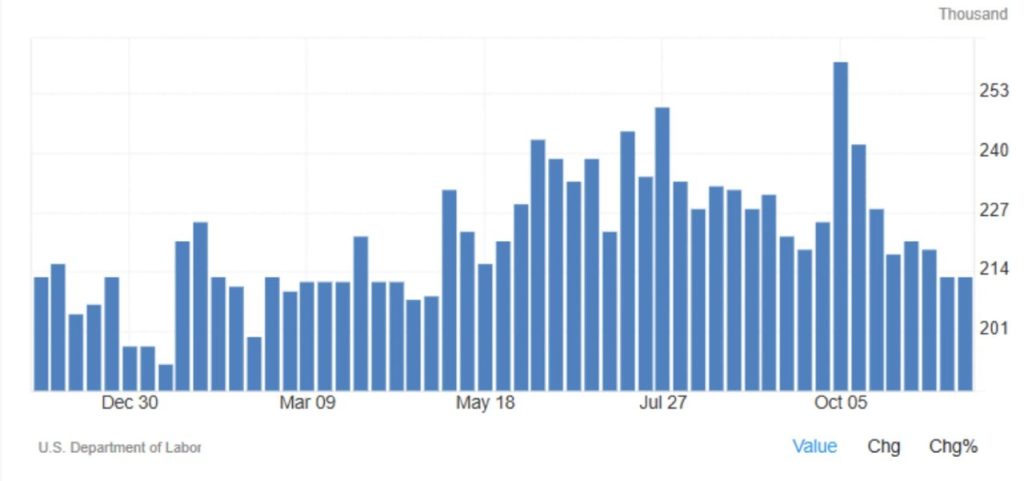
US Jobless Claims Hold Steady Amid Resilient Labor Market
Initial jobless claims in the US held steady at 213,000 for the week ending November 23, below market expectations of 216,000. This steady performance underscores the enduring strength of the labor market, even as the Federal Reserve’s aggressive monetary tightening in recent quarters aimed to slow economic activity. The data bolsters confidence in a historically robust labor environment, suggesting that employers are reluctant to cut jobs despite lingering economic uncertainties.
The numbers reflect the labor market’s role as a key pillar of the US economy, providing stability even as inflation and higher borrowing costs challenge other sectors. With jobless claims consistently low, the Federal Reserve has more leeway to navigate its dual mandate of supporting employment and controlling inflation.

Four-Week Average Declines, Indicating Strength
The four-week moving average, a key metric for gauging longer-term trends, dropped by 1,250 to 217,000. This decline highlights the resilience of the labor market despite significant monetary tightening over the past year. By smoothing out week-to-week fluctuations, the moving average provides a clearer picture of employment stability, showing that layoffs remain low and businesses are largely retaining their workforce.
This consistent labor strength aligns with broader economic signals pointing to cautious optimism. While certain industries face headwinds, the overall demand for labor remains high, with many employers continuing to expand or maintain their payrolls in response to steady consumer activity and business investment.
Non-Seasonally Adjusted Claims See Localized Increases
While seasonally adjusted jobless claims held steady, the non-seasonally adjusted claims rose by 29,101 to 243,389. Much of this increase came from sharp rises in states like California (+4,974), Illinois (+2,924), and Pennsylvania (+2,758). These localized spikes may reflect temporary factors such as seasonal hiring fluctuations or industry-specific challenges rather than a broader trend of economic weakness.
Despite these increases, the national labor market continues to show resilience. Employers in many regions remain focused on retaining talent, balancing short-term economic pressures with the long-term challenges of filling positions in a tight labor market.
Continuing Claims Reach Two-Year High
Continuing jobless claims, which track the number of people receiving unemployment benefits after an initial claim, rose to 1.91 million, the highest since November 2021. This rise suggests that while layoffs remain low, some individuals are taking longer to re-enter the workforce. Factors like skill mismatches, regional economic shifts, or industry transitions may be contributing to this trend.
Even with the increase in continuing claims, the broader labor market remains robust. The combination of steady initial claims and relatively low layoffs provides a buffer for the economy as it navigates inflationary pressures and tighter monetary conditions. For the Federal Reserve, these numbers may reinforce a cautious approach to slowing the pace of monetary loosening, ensuring that inflationary pressures are addressed without derailing the labor market’s recovery.
As the year progresses, the resilience of the job market will remain a critical factor in shaping economic policy and overall growth. With initial claims holding steady and the broader labor market performing well, the US economy continues to demonstrate its ability to weather challenges while maintaining employment stability.
Share
Hot topics

Federal Reserve’s Challenges to Trump’s New Policies
As the Federal Reserve Open Market Committee (FOMC) prepares for its upcoming meeting, all eyes are on how the Fed will respond to Donald Trump’s latest economic policies. With the...
Read more




Submit comment
Your email address will not be published. Required fields are marked *